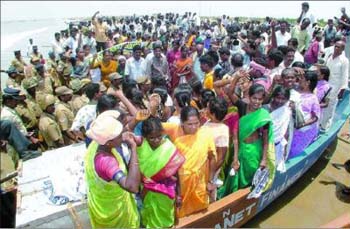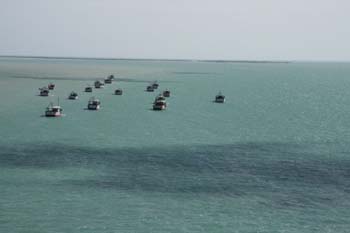| |
|
 |
ARC's Sacred Site Nomination Boosts Campaign to Save Gulf of Mannar
December 12 2008:
 |
 |
 |
Fisherfolk staging a demonstration against the SSCP at the Arcottuthurai coast in Vedaranyam on August 12. From The Living Planet Foundation website |
PRESS RELEASE FROM THE LIVING PLANET FOUNDATION: At the first international meeting of the campaign to protect the Gulf of Mannar, held at the Linnean Society in London this week, ARC announced that it would be seeking to have the Gulf of Mannar designated as one of the world’s first internationally recognised ‘Sacred Sites.’
 |
| The story was picked up by Ecumenical News International. Link here for their article.
|
|
 |
 |
Following agreements reached at the IUCN World Conservation Congress in Barcelona last month, ‘Sacred Site’ is a now an international term of protection for sites that are spiritually, religiously, culturally and ecologically important. In the fight to save the Gulf of Mannar from destruction by the creation of a deep shipping channel, the move could prove to be a strategically important one.
Flowing between South-East India and Sri Lanka, the Gulf of Mannar is home to Ram Sethu, or Adam’s Bridge, a site of immense spiritual significance to both Hindus and Muslims worldwide. Situated in South-Asia’s largest biosphere reserve, it is also one of the last remaining biological hotspots on the planet, offering sanctuary to numerous endangered plant and animal species such as the dugong and the green turtle.
However, despite the clear cultural, natural and spiritual importance of the area, and in the face of an on-going challenge in the Supreme Court of India, the Indian government is pressing ahead with dredging for the planned Sethusamudram Ship Channel, risking destruction of the sacred bridge and the fragile eco-system of the area.
 |
 |
 |
Fishing boats in the Gulf of Mannar |
The announcement of nomination for Sacred Site status was made by Martin Palmer, Secretary General of ARC, and religion and ecology advisor to His Royal Highness the Prince Philip, Duke of Edinburgh.
“The Gulf of Mannar has enormous spiritual significance within both Hinduism and Islam,” he said during his announcement.
“Narratives in the Hindu Ramayana, which feature Ram Sethu, and the Muslim story of Adam being thrown out of Paradise and falling into what we now know as Sri Lanka, then walking across Adam’s Bridge to become the vice-regent of God ruling the world, make the Gulf of Mannar the one place in the world – other than the Garden of Eden – where we could actually say ‘this is a sacred site about our relationship with and our responsibility for the rest of creation.’
"Cosmologically and ecologically the Gulf of Mannar is about as sacred a site as you could get. Our suggestion is that it should be nominated as one of the very first internationally significant sacred sites, along with places such as the sacred mountains of China and other such hugely holy and ecologically significant places. I have every confidence the nomination will succeed.”
Organisers of the campaign to protect the Gulf of Mannar have been quick to welcome the news.
“Mr Palmer’s announcement was dramatic and unexpected,” says Kusum Vyas, founder of The Living Planet Foundation, which organised the London meeting. “The meeting erupted into applause when he made the announcement – it was so thrilling. To get the Gulf of Mannar recognised on the international conservation stage will be a huge step forward in preserving its sanctity and ecology for future generations. We can’t thank ARC enough.”
Asked to reflect on the current battle to preserve the Gulf of Mannar, Mr Palmer said: -
“It is a classic struggle – to use Christian terminology – between God and Mammon, between those who see the world as a stage upon which a drama of cosmological significance is played out in which every aspect of creation has significance and meaning because it is created from love, and those who simply see this planet as a rather large supermarket to be raided.”
For further details please see the Living Planet Foundation website.
IUCN, the International Union for Conservation of Nature, is world’s oldest and largest global environmental network - a democratic membership union with more than 1,000 government and NGO member organisations, and almost 11,000 volunteer scientists in more than 160 countries – it helps find pragmatic solutions to pressing environment and development challenges.
The first international meeting of the campaign to protect the Gulf of Mannar was held at the Linnean Society in London on Tuesday and Wednesday this week - November 24 and 25 - and was organised by The Living Planet Foundation, USA.
Background on the Gulf of Mannar
- The Gulf of Mannar is located on the southeastern tip of India in the state of Tamil Nadu. It is one of the world's few remaining hotspots in terms of the exceptional biodiversity of its terrestrial and marine ecosystems.
- As an outstanding example of an ongoing geological process, the Gulf of Mannar provides the habitat for rare and endangered plant and animal species, including the threatened green turtle and the dugong.
- The sheltered Gulf, free from oceanic currents, also provides the calving grounds for a substantial part of the diverse whale population of the Bay of Bengal.
- Around 3,600 species of fauna and flora have been identified in the area, which comprises three different ecosystems - sea grass, mangrove and coral reef. The shallow waters in the area have the highest concentration of sea grass species along India's 7,500 km coastline. Eleven species of seagrass recorded in India are found in the reserve, with the island's surrounding shallow waters harbouring three species of seagrass found nowhere else in India. The same shallow waters are also known to have at least 147 species of marine algae/seaweed.
- These meadows support complex ecological communities and being among the largest remaining feeding grounds for the globally endangered dugong, are of global significance. Additionally five species of marine turtles, innumerable fish, seahorse, molluscs and crustaceans also feed here.
- Culturally and religiously the Gulf of Mannar is an extremely important region. The centuries old pearl and conch shell diving tradition still exists there, the Gulf's limestone reefs forming an essential habitat for the fabled Pearl oyster beds, once the source of fabulous treasures from ancient Egypt, Greece and Rome.
- The Gulf is the site of the famous Ram Sethu, or Adam's Bridge, which according to Hindu scriptures (the Ramayana) was created by Lord Rama in order to rescue his wife, Sita. The Bridge also features in later Islamic narratives.
The above details were provided courtesy of the "First International Meeting of the Campaign to Designate the Gulf of Mannar as a UNESCO World Heritage Site".
The story was picked up by Ecumenical News International. Link here for their article.
|
 |
 |
|
|
|
|
|
 |
Vision and Strategy
ARC's vision is of people, through their beliefs, treading more gently upon the earth. Link here to find out how we achieve this.
|
 |
What makes a place sacred?
Think about the places in your area that make you feel happy or at peace. Are they enjoyed by other people? Could they be? Are they places that enhance nature? Or could they be made more beautiful? If you have no such places, then think about creating one. |
 |
December 18, 2008:
Muslim Seven Year Plan Emerges
Representatives from Islamic NGOs, academics, government figures and Muslim environmental activists held a meeting in Kuwait to focuss on the Muslim Seven Year Plan. Islamic states and Muslim communities from all over the world will be invovled in creating a Muslim plan for generational change. |
 |
 |
|
|

